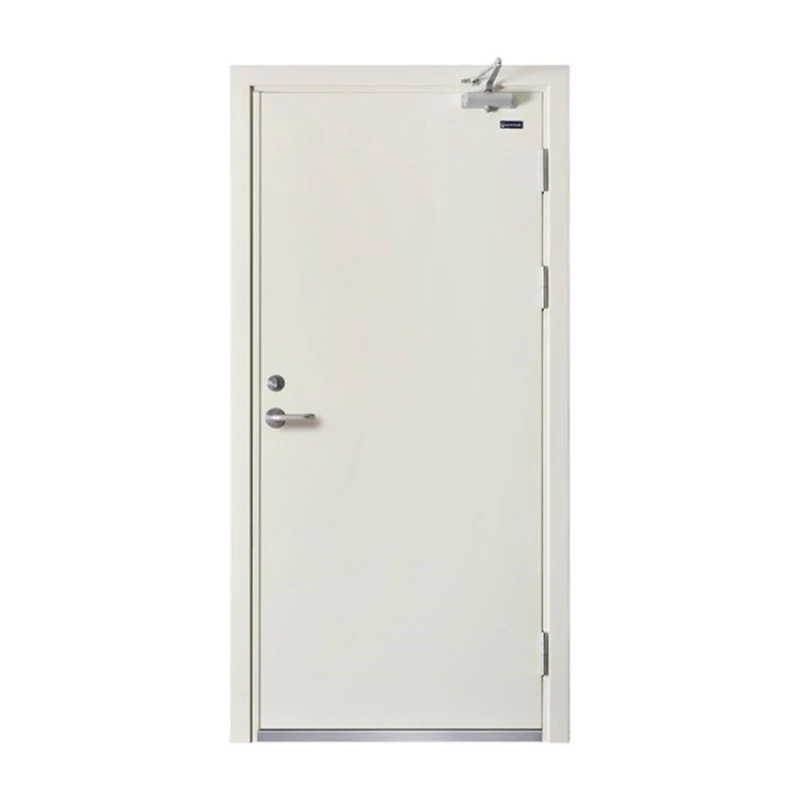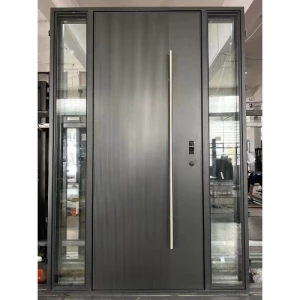Factory Wholesale Single Fireproof Door
- Standard Size
- 2050*960 (Accept Customization)
- Door Leaf Thickness
- 60mm (Accept Customization)
- Inner Filling
- Fire door core board (Accept Customization)
- Lock Set
- High Quality Main Lock+Side Lock+Up-Down Lock
- Surface Treatment
- Poder Coated/Heat Transfer(Customized)
- Open Direction
- Inward/Outward/Left/Right
- Accessories
- Handle; Lock;Hinge;Peephole;Door Bell;Bolts
Fire Resistance of Steel Doors
Introduction
Steel doors are widely recognized for their strength and durability. In addition to these qualities, steel doors also offer a high level of fire resistance, making them an excellent choice for fire safety. In this article, we will explore the fire resistance of steel doors and the factors that contribute to their effectiveness.
1. Construction and Design:
The construction and design of steel doors contribute significantly to their fire resistance. Key aspects include:
a. Steel Frame: Steel doors are typically built with a strong steel frame, which enhances their structural integrity and resistance to fire. The frame helps maintain the door's stability under high heat conditions.
b. Door Leaf: The door leaf itself is constructed from fire-rated steel, which is designed to withstand exposure to fire for a specified duration. The thickness of the steel used in the door leaf affects its fire resistance, with thicker steel providing greater protection.
c. Reinforcements: Steel doors may include additional reinforcements, such as fire-rated hardware, expansion strips, and fire-resistant seals around the edges. These elements help prevent the spread of fire, smoke, and hot gases.
2. Fire Ratings:
Steel doors are classified based on their fire ratings, indicating their ability to withstand fire for a specific period. Common fire ratings for steel doors include:
a. 20-Minute Fire Rating: Steel doors with a 20-minute fire rating can resist fire and prevent its spread for up to 20 minutes. They are commonly used in residential buildings and small commercial spaces.
a. 60-Minute Fire Rating: Steel doors with a 60-minute fire rating offer increased fire resistance, capable of withstanding fire for up to 60 minutes. They are often installed in larger commercial buildings and industrial facilities.
c. 90-Minute Fire Rating: Steel doors with a 90-minute fire rating provide the highest level of fire resistance. They are suitable for buildings with more stringent fire safety requirements, such as hospitals, schools, and high-rise structures.
3. Fire-Resistant Coatings
To enhance the fire resistance of steel doors, they can be coated with fire-resistant materials, such as:
a. Fire-Rated Paint: Fire-rated paint is specifically formulated to provide a protective layer on steel surfaces, helping to slow down the spread of fire and reduce heat transfer.
b. Expansion Coatings: Expansion coatings are applied to steel doors and expand when exposed to high temperatures, forming a charred layer that insulates the door and provides additional fire protection.
4. Testing and Certification
Steel doors undergo rigorous testing procedures to determine their fire resistance capabilities. Various testing standards, such as UL (Underwriters Laboratories) and ASTM (American Society for Testing and Materials), evaluate factors like fire endurance, smoke leakage, and structural integrity. Certification from recognized testing authorities ensures the reliability and compliance of steel doors with fire safety regulations.
Conclusion
Steel doors offer excellent fire resistance, making them a reliable choice for enhancing building safety. Their robust construction, fire ratings, fire-resistant coatings, and adherence to testing standards contribute to their effectiveness in preventing the spread of fire and protecting occupants. When selecting steel doors for fire safety applications, it is essential to consider their specific fire ratings and ensure compliance with relevant building codes and regulations. For more information please contact USELUCK DOOR. We have all kinds of fire door such as Y2S001C031, Y2S01C066.
We have more categories for you. lf you can't find the products you want above,just fill in the form and tell us whatproducts you want to import from China.





















